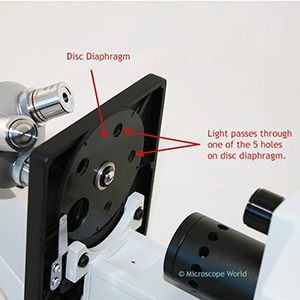Troubleshooting Microscope Lighting
Without a working light on the microscope, especially on a compound microscope, it can be nearly impossible to view microscopy specimens. Below you will find multiple microscope troubleshooting tips for ensuring the microscope light bulb is working and light can pass from the microscope illuminator to the eyepieces.
Is the microscope turned on & rheostat turned up?
Make sure the microscope is plugged in and switched on. Many microscopes have a rheostat control (either a knob or a small flat dial built into the microscope base). Make sure the rheostat control is turned up to the brightest level.
Is the microscope field iris opened up?
The microscope field iris is part of the microscope condenser. The condenser is located beneath the microscope stage and above the microscope light on a compound microscope. The field iris adjusts the amount of light that travels through the condenser and up through the microscope eyepieces. If the field iris is completely shut down it will not allow any light to travel up the microscope to the eyepieces and will result in dark images when looking through the microscope. The image below shows where the field iris is located.

Is the microscope beam splitter engaged?
If you are using a trinocular microscope (a microscope with a camera port), there is most likely a lever on the side of the microscope that can be pulled out or pushed in. This lever is called a beam splitter and directs light from the eyepieces up toward the camera. In some microscopes when the beam splitter is engaged both eyepieces will go completely dark. Make sure the beam splitter is not pulled out and engaged.
Is the microscope disc diaphragm in place?
On many student microscopes or kids microscopes the light passes through a disc diaphragm rather than a field iris. The disc diaphragm is located beneath the stage. The disc diaphragm typically has five holes drilled into a disc that can be rotated to allow different amounts of light to pass through the specimen.


Is the microscope bulb burned out?
If your microscope has been used for a while it is possible that the microscope light bulb may need to be replaced.
Is the microscope fuse burned out?
A burned out fuse will cause the microscope light to quit working. Consult your microscope instruction manual for fuse replacement instructions.
If you are using a cordless microscope has it been charged?
Cordless microscopes will not work if the batteries get low and have not been charged.
